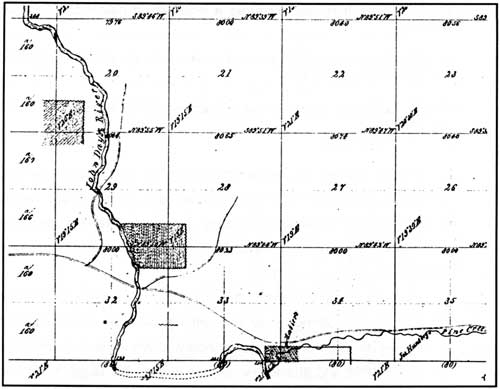|
John Day Fossil Beds Historic Resources Study |

|
Chapter Four:
SETTLEMENT (continued)
Early Settlement in the Vicinity of the National Monument (continued)
Clarno Unit
The Clarno Unit is located east of the John Day River and north of Pine Creek in T7S, R19E, W.M. Iron Mountain runs diagonally through the center of the township. The tract lies near the eastern border of Wheeler County, close to the Wasco County line.
Settlement in the vicinity of Clarno concentrated along the river corridor to the west and commenced in the late 1860s, with the arrival of the Andrew and Eleanor Clarno family. Cadastral surveyors subdivided the township in October, 1873. At that time they noted the farms of "Matier" [Mettur] and Joseph Huntley on Pine Creek in sections 33-34 and 35. Huntley also had a large, fenced field on the east bank of the John Day River in sections 28, 29, 32, and 33. A partially fenced field lay in the bottomland a mile downstream on the west bank (Perkins 1873).
The cadastral survey plat of 1873 indicates that the cabins of George Mettur or "Matier" and Joseph Huntley lay just outside of the lands now within the National Monument. Huntley's house was on the south bank of Pine Creek. In 1880, George J. Mettur (Matier) purchased 120 acres in Section 34, the first deed issued in the township. Joseph Huntley did not secure his homestead patent until 1891.

Fig. 15. House locations of Joseph
Huntley and Matier (Mettur) on Pine Creek, 1873 (Perkins
1873).
The BLM Master Title Plat, Historical Index, and Control Data Inventory confirm grants and filings on lands within the Clarno Unit, as given below. Claims filed under the Homestead Act which were later relinquished are not identified by name in the Control Data Inventory; only the serial number and dates of filing and relinquishment are preserved.
T7S, R19E, W.M.
Section 23 All of the SW 1/4 was filed upon 11/4/1901 under the Homestead Act; the claim was relinquished 11/02/1909.
Section 34 George Mettur purchased 120 acres, SWSW, SESW, and SWSE on 6/1/1880.
Section 34 Joseph Huntley secured a Homestead patent to SESE on 10/21/1891.
Section 35 Joseph Huntley secured a Homestead patent to SWSW, SESW, SWSE on 10/21/1891.
Section 35 Edward Lee purchased 120 acres, NESE, NWSE, and SESE on 10/02/1891.
(BLM n.d.d, n.d.e, n.d.f)
The especially rugged nature of this township precluded extensive settlement. Between 1887 and 1912 the General Land Office logged twenty cancellations on claims and issued sixteen deeds. More than half who attempted to settle failed to meet the terms of proof under either the Homestead Act or the Desert Land Act (BLM n.d.d, n.d.e, n.d.f).
Although their lands lay outside the boundaries of the present-day Clarno Unit of the Monument, the Clarno family was among the most successful and long-lived of ranching families in the area. Andrew Clarno first examined the John Day country in 1866 and, the following year, moved his large family and 300 head of cattle from Eugene to land on the Wasco County side (west bank) of the John Day River, one-half mile downstream from the present-day crossing of SR 218. The Clarnos operated a ferry crossing where the bridge now stands, and gave their name to the locality where a school, post office, hotel, and grange hall were established at various times over the next several decades (Campbell 1976:13-14).
The Clarno family lived in a log cabin for a year before constructing a permanent home. Son John Clarno, a skilled teamster at age eighteen, was dispatched to pick up a double wagon load of milled lumber at The Dalles and haul it to the homestead with a team of twenty-four oxen (Campbell 1976: 15-22). On a site near the river, they built a home of plank box construction, with wrought iron nails and a full-width front porch. Little is known of the physical development of the ranch. The family put in a garden, maintained a fruit orchard, and raised fine horses. The Clarno cattle ranching operation was renowned, and financially prosperous. Clarno cattle were trailed to Union Pacific Railroad railheads in Utah, Wyoming, and Nevada. As many as fifteen cowhands were employed during round-ups, and over 100 saddle horses were raised for use on the ranch (Campbell 1976: 21-23).

Fig. 16. Clarno School, moved ca. 1893
from from a site on Sorefoot Creek to the Andrew Clarno homestead, n.d.
(OrHi 66175)
The family holdings grew as the children reached adulthood. In 1881, son John W. Clarno completed residency and proof to obtain a homestead patent to 160 acres in Section 32 on the Wheeler County side of the river. For reasons uncertain, Andrew Clarno did not receive patent to his original homestead until 1889 (Campbell 1976: 14). Andrew and son Charles Clarno both purchased additional lands in this vicinity in 1889 and 1890. In 1912, John Clarno sold his parents' original homestead, signaling the end of a colorful era in local history (Campbell 1967:14, 88).
| <<< Previous | <<< Contents >>> | Next >>> |
joda/hrs/hrs4f.htm
Last Updated: 25-Apr-2002